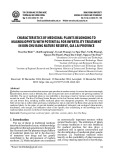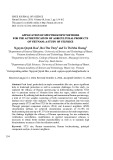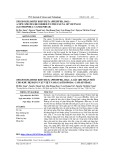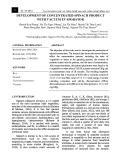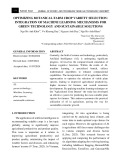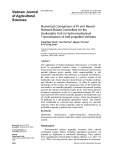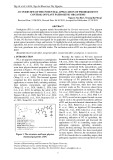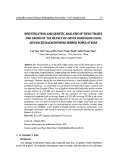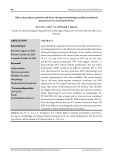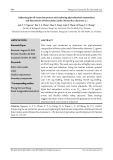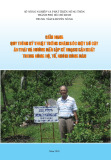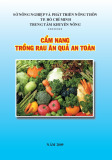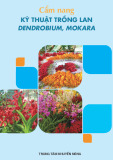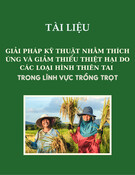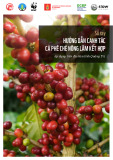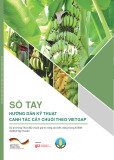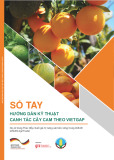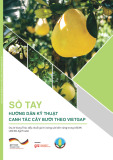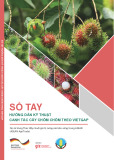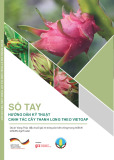
Vietnam Journal
of Agricultural
Sciences
ISSN 2588-1299
VJAS 2024; 7(3): 2208-2216
https://doi.org/10.31817/vjas.2024.7.3.03
2208
Vietnam Journal of Agricultural Sciences
Received: March 4, 2024
Accepted: August 06, 2024
Correspondence to
nbthang@sina.com
ORCID
Nguyen Ba Thang
https://orcid.org/0000-0001-8737-
669X
Combining Ability Analysis for Quality Traits
in Selected Rice Varieties (Oryza sativa L.)
Nguyen Ba Thang
Independent researcher, Hoai Duc, Hanoi 13200, Vietnam
Abstract
Fifteen hybrid combinations developed by crossing five lines and
three testers were assessed for milling and physio-chemical qualities
to evaluate the combining ability of the parents using a line x tester
design. This investigation provided information about the general
combining ability (GCA) of parents and the specific combining
ability (SCA) effects of crosses from eight popular inbred varieties.
C70 was considered the best general combiner for the head rice
recovery trait, while the crosses involving C70 with DH18 and
CR203, 13/2 with TBR225 and Xi23, and OM6976 with TBR45
showed significant positive specific combining ability (SCA) effects.
Xi23 and OM6976 among the lines showed significant general
combining ability (GCA) effects indicating them to be good general
combiners for obtaining hybrids with desirable (low or intermediate)
properties of amylose content. The variances due to SCA were of
greater magnitude than GCA for all the traits, revealing the
preponderance of non-additive gene action for all the studied
attributes. In all the studied quality traits, the narrow sense
heritabilities were ordered as follows: head rice recovery > amylose
content > gel consistency > alkali digestion > hulling percentage >
milling percentage. The narrow sense heritabilities in these traits
were quite low, ranging from 8.11% to 14.4%. Among the eight
parents, C70, Xi23, and TBR225 were the most ideal for high-quality
line breeding.
Keywords
Rice, combining ability, GCA, SCA, quality characters, line ×
tester.
Introduction
As a result of economic development and improvements in living
standards, rice quality has become a major factor in rice production
due to its effect on market value and farmer incomes (Clarete et al.,
2013). The primary components of rice grain quality influencing
commercial value include appearance and milling, cooking, and eating

Nguyen Ba Thang (2024)
https://vjas.vnua.edu.vn/
2209
quality, which are determined by both physical
and chemical properties. Of these, the head rice
recovery determines rice producer incomes,
whereas the amylose content of the rice grains is
recognized as one of the most important
determinants of eating and cooking quality.
Success in any breeding program for improving
traits such as grain quality depends upon the
appropriate selection of parents and
crosses.Neobenedenia spp. have a direct life
cycle and short generation
Combining ability analysis is one of the
useful tools available to determine the combining
ability effects and helps breeders select desirable
parents and hybrids for new variety development
in many kinds of crops such as sorghum (Duan et
al., 2016), soybean (Otusanya et al., 2022), corn
(Yu et al., 2020), sunflower (Jockovic et al.,
2018), common bean (Franco et al., 2001), and
rice (Asfaliza et al., 2012; Maleki et al., 2014).
The line × tester analysis enables the estimate of
different types of gene actions and also provides
information about the general combining ability
(GCA) of parents and the specific combining
ability (SCA) effects of crosses (Kempthorne,
1957). The occurrence of non-additive gene
effects for quality traits in rice has been found in
earlier investigations for milling percentage,
head rice recovery, amylose content, and gel
consistency (Chen et al., 2017; Buelah et al.,
2020; Bhatt et al., 2022). Differences between
broad-sense and narrow-sense heritability reveal
the role of additive or non-additive gene effects
in controlling rice quality traits and have been
demonstrated by many scholars (Ao et al., 2000;
Deng et al., 2006; Zhan et al., 2015; Awad-Allah
et al., 2016). Therefore, the present investigation
was undertaken to assess the combining ability of
indica parents based on the performance of their
hybrids, which will help breeders in identifying
the parents and crosses that have desirable
quality components.
Materials and methods
Plant materials and experimental design
Five high-yielding varieties (CR203, C70,
13/2, Xi23, and OM6976) were selected to cross
with three good quality varieties (DH18,
TBR225, and TBR45) to produce 15 hybrids
following the line x tester mating design
(Kempthorne, 1957) in the 2021 summer season.
The F1s along with their parents were sown on
the 25th January 2022 (spring season) in Hoai
Duc district, Hanoi. The experiment was laid out
in a randomized complete block design with
three replications. Eighteen-day-old seedlings of
the 15 F1 hybrids along with their parents were
transplanted in 3m-long rows per plot, at 1
seedling per hill and intra- and inter-row
distances of 15cm and 20cm, respectively.
Recommended field management practices were
followed from transplanting to harvesting to raise
a healthy crop.
After harvesting, 0.7-1.0kg of each genotype
was sampled to measure milling quality (hulling
quality, milling percentage, and head rice recovery)
according to the procedures from the International
Rice Research Institute (IRRI, 1996).
To test the hulling percentage (HULL), a
known quantity of rough paddy was cleaned, air-
dried to 13-14% moisture content, and dehulled
with a McGill Laboratory Sheller. The hulling
percentage was estimated as follows:
Hulling percentage =
Weight of hulled rice (g)
Weight of rough rice (g)
x 100.
To estimate the milling percentage (MILL)
after hulling, the brown rice was milled and
polished in a Kett polisher for a standard time to
get the milling percentage. The milling
percentage was estimated as follows:
Milling percentage =
Weight of milled rice (g)
Weight of rough rice (g)
x 100.
To test the head rice recovery percentage
(HRR), the milled samples were screened to
separate the whole grains from the broken ones.
The small portion of broken kernels that passed
along with the whole kernels were separated by
hand. Head rice recovery, which is the estimate
of full size plus three-fourth size kernels, was
expressed in the following percentage:
Head rice recovery =
Weight of head rice (g)
Weight of rough rice (g)
x 100.
The amylose content was measured by the
procedures described by TCVN5716: 2008, gel

Combining ability analysis for quality traits in selected rice varieties (Oryza sativa L.)
2210
Vietnam Journal of Agricultural Sciences
consistency was estimated according to
TCVN8369: 2010, and alkali digestion was
determined following the protocol of TCVN
5715: 1993. For alkali digestion, a seven-point
scale was used in assigning different values
based on kernel spreading (IRRI, 1996).
Data analysis
Statistical analysis was carried out using
sample mean values. The data were analyzed for
combining ability according to Griffing’s (1956)
model I (genotypes and blocks as fixed-effects)
and their variance was calculated using the
“Agricolae” package in Rstudio version 4.0.5
and Excel according to the model suggested by
Kempthorne (1957).
Results and discussion
Variance and combining ability variance
analysis
The analysis of variance revealed significant
differences among genotypes including the lines,
testers, and crosses (Table 1) in most of the
characteristics. This implied that the treatments
had wide genetic diversity among themselves.
The GCA variance of the lines was found to be
significant or highly significant for almost all the
investigated quality traits, except for the milling
percentage trait, which confirmed that the lines
in this study did not influence the milling
percentage but had different effects on other trait
expressions in the crosses. Analysis of the tester
GCA variance showed non-significant effects on
the hulling percentage and gel consistency traits
but highly affected the milling percentage, head
rice recovery, amylose content, and alkali
digestion traits, which implied that the testers had
different influences on the studied trait
expressions in different crosses.
The major role of the non-additive gene
effects in the performance of all the traits was
determined by a lower value of the general
combining ability variance (δgca2) than the
specific combining ability variance (δsca2). In this
study, the ratio of δgca2/ δsca2 was less than unity
for all the quality traits, indicating a
preponderance of non-additive genetic variance
(Table 1). This suggested a greater role of non-
additive gene action in their expression and
offers good prospects of the exploitation of
genetic variation for grain and its component
characteristics through hybrid breeding.
Analysis of combining ability effects
* Significant at the 0.05 level and **
Significant at the 0.01 level
The GCA effects manifested significant
differences. The GCA effects of the same traits
or of the same male or female parent were varied,
indicating there was no consistent trend for the
genotypes or quality traits (Table 2). Regarding
the milling quality traits, head rice recovery is
rice’s most important quality parameter since it
is positively related to the grower’s preference
and income in most rice segments. The C70
variety was identified as having the highest GCA
effect (4.04) followed by 13/2 (2.87), and
OM6976 had the lowest negative effect (-7.21),
whereas only DH18 expressed a significantly
positive GCA effect, and TBR45 and TBR225
were determined to have significantly negative
GCA effects in the tester group for head rice
recovery. This implied that C70 and DH80
exhibited good general combining ability effects
for this trait.
For the physio-chemical traits like gel
consistency, amylose content, and alkali
digestion, the choice of parents for developing
specific crosses depends on consumer
preference. Current customers expect low
amylose content, high gel consistency, and
medium alkali digestion. Among the lines, Xi23
and OM6976 showed significantly negative
GCA effects for the amylose content traits
whereas CR203 and 13/2 exhibited significant
positive ones. For the testers, TBR45 and
TBR225 displayed significantly negative effects
whereas DH18 was found to have a significantly
positive effect for the amylose content trait.
Regarding the gel consistency, all the lines
showed highly significant effects (P <0.01), and
only OM6976 among the lines was found to have
a positive GCA effect, whereas no tester had a
GCA effect for the gel consistency trait (Table 2).

Nguyen Ba Thang (2024)
https://vjas.vnua.edu.vn/
2211
Table 1. Analysis of variance for combining ability for the six investigated quality traits
Variance source
DF
HUL
MIL
HRR
AC
GC
ALK
Replication
2
0
0.07
1.2
0.02
1.06
0.19
Genotypes
22
3.97**
10.82**
80.71**
29.90**
677.36**
5.71**
Parents
7
6.31**
14.00**
50.44**
68.38**
1249.69**
6.85**
Parents vs crosses
1
17.49**
11.55**
234.59**
56.39**
5975.5**
0.24
Crosses
14
1.83**
9.18**
84.85**
7.52**
14.76**
5.52**
Line
4
4.05*
9.76
173.08**
15.47**
46.09**
9.06*
Tester
2
1.49
24.77*
190.82**
15.82**
0.62
14.46**
Line× Tester
8
0.80**
4.99**
14.25**
1.48**
2.62**
1.52**
Error
44
0.04
0.21
0.73
0.01
0.75
0.25
δgca2
0.04
0.15
2.50
0.21
0.43
0.14
δsca2
0.26
1.59
4.51
0.49
0.62
0.42
δgca2/ δsca2
0.14
0.09
0.55
0.44
0.69
0.34
Note: HUL: hulling percentage (%), MIL: milling percentage (%), HRR: head rice recovery (%), AC: amylose content (%), GC: gel consistency (mm), ALK: alkali digestion (score)
* Significant at the 0.05 level and ** Significant at the 0.01 level

Combining ability analysis for quality traits in selected rice varieties (Oryza sativa L.)
2212
Vietnam Journal of Agricultural Sciences
Table 2. Effects of general combining ability for the main quality characteristics in the parents
Parents
HUL
MIL
HRR
AC
GC
ALK
Lines
CR203
-0.72 **
-1.44 **
-0.24
1.03 **
-1.6 **
-1.09 **
C70
0.2
1.22 *
4.04 **
0.04
-2.04 **
1.13 **
13/2
0.82 **
0.77 *
2.87 **
1.54 **
-1.16 **
-0.98 **
Xi23
0.36 **
-0.13
0.54
-1.22 **
1.73 **
1.02 **
OM6976
-0.66 **
-0.42
-7.21 **
-1.4 **
3.07 **
-0.09
Testers
DH18
-0.26 **
0.62 **
3.99 **
1.05 **
-0.04
-0.73 **
TBR45
-0.08
-1.48 **
-1.12 **
-1.02 **
0.22
-0.13
TBR225
0.35 **
0.86 **
-2.88 **
-0.03 **
-0.18
0.87 **
SE (gi for line)
0.063
0.151
0.285
0.063
0.29
0.127
SE (gj for tester)
0.049
0.117
0.221
0.049
0.224
0.098
SE (gi-gj) line
0.089
0.214
0.403
0.089
0.41
0.179
SE (gi-gj) tester
0.069
0.166
0.312
0.069
0.317
0.139
Note: HUL: hulling percentage (%), MIL: milling percentage (%), HRR: head rice recovery (%), AC: amylose content (%), GC: gel
consistency (mm), ALK: alkali digestion (score)
Table 3. Effects of specific combining ability for the main quality characteristics in the F1 combinations
Cross
HUL
MIL
HRR
AC
GC
ALK
CR203 × DH18
0.43 **
1.3 **
0.78
-0.02
0.27
0.87
CR203 × TBR45
0.12
-2.27 **
-2.82 **
-0.28**
0.67 **
0.20
CR203 × TBR225
-0.55 **
0.97 **
2.04 **
0.29 **
-0.93 **
-1.07
C70 × DH18
0.18
-0.62 *
0.03
0.25 **
-0.62 **
-0.13
C70 × TBR45
-0.14
0.71 *
0.24
-0.03
-0.89 **
-0.47
C70 × TBR225
-0.04
-0.09
-0.27
-0.26 **
1.51 **
0.60
13/2 × DH18
-0.85 ***
-1.28 **
-1.09 *
0.78 **
0.49 *
0.20
13/2 × TBR45
0.47 **
1.36 **
-1.08 *
-0.13
0.22
0.20
13/2 × TBR225
0.38 **
-0.78 **
2.18 **
-0.66 **
-0.71 **
-0.40
Xi23 × DH18
0.28 *
0.16
0.50
-1.25 **
-0.40 *
0.36
Xi23 × TBR45
-0.04
-0.21
2.54 **
0.77 **
0.67 **
0.36
Xi23 × TBR225
-0.24 *
0.6 *
-3.04 **
0.48 **
-0.27
0.71
OM6976 × DH18
-0.04
0.44
-0.21
0.22
0.27
-0.58
OM6976 × TBR45
-0.42 **
0.41
1.13 *
-0.36 *
-0.67 **
0.42
OM6976 × TBR225
0.45 **
-0.86 **
-0.91
0.14
0.4 *
0.16
SE (gij-sca effect)
0.11
0.26
0.49
0.07
0.50
0.29
SE (gsij-skl)-tester
0.15
0.37
0.70
0.10
0.71
0.41
Note: HUL: hulling percentage (%), MIL: milling percentage (%), HRR: head rice recovery (%), AC: amylose content (%), GC: gel
consistency (mm), ALK: alkali digestion (score)
* Significant at the 0.05 level and ** Significant at the 0.01 level

